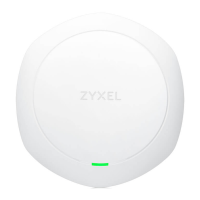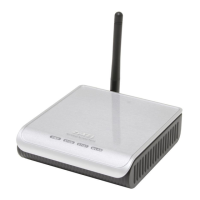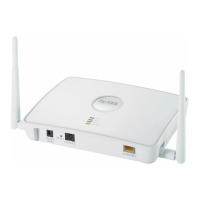Chapter 6 WiMAX
HES-309M Series User’s Guide
64
This screen contains the following fields:
Table 13 Connect
LABEL DESCRIPTION
Applied Frequency Information
This table shows the scanning result you made in the WiMAX > Profile > Frequency
Settings and WiMAX > Wide Scan screens.
Note: You cannot see the wide scanning result that you made in WiMAX > Wide
Scan screen if the Join Wide Scan Result is set to No in the WiMAX >
Profile > Frequency Settings screen.
Frequency
(KHz)
This field displays the available center frequency of a frequency band in
kilohertz (KHz).
Bandwidth
(MHz)
This field displays the bandwidth of the frequency band in megahertz
(MHz).
Available Network List
Connected
Mode
Select a connect mode:
• Auto Connect Mode - This allows the WiMAX Device to connect to
any of the base stations on the list automatically.
• Network Search Mode - This allows the WiMAX Device to connect
to a user-specified base station. Select this option, choose a base
station, click Connect.
Connect Click this to connect to the selected base station.
Disconnect Click this to disconnect from the selected base station.
BSID This field displays the base station MAC address.
Preamble ID This field displays the preamble ID.
The preamble ID is the index identifier in the header of the base
station’s broadcast messages. In the beginning of a mobile stations’s
network entry process, it searches for the preamble and uses it to
additional channel information.
The preamble ID is used to synchronize the upstream and downstream
transmission timing with the base station.
Frequency
(MHz)
This field displays the center frequency the base station uses in
kilohertz (KHz).
Bandwidth
(MHz)
This field displays the frequency band bandwidth the base station uses
in megahertz (MHz).
RSSI (dBm) This field displays the Received Signal Strength Indication (RSSI),
which is an overal measurement of radio signal strength. A higher RSSI
level indicates a stronger signal.
CINR (dB)
R3/R1
This field displays the average Carrier to Interference plus Noise Ratio
for the current connection. This value is an indication of overal radio
signal quality, where a higher value means a better quality signal.
Search Click this to have the WiMAX Device scan for base stations in the
frequency band(s) listed in the Applied Frequency Information
table.
Connected BS Info

